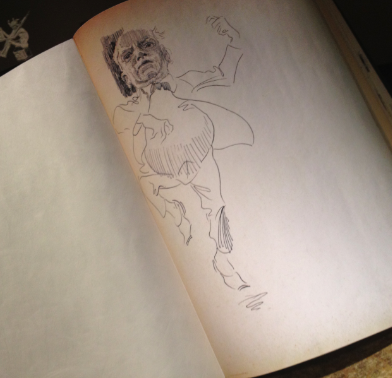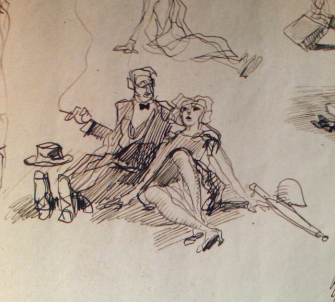Heinrich Kley’s influence on Walt Disney is undeniable. In 1935, Walt travelled extensively through Europe and returned with a handful of pieces by the German artist. Walt was drawn to the drama and emotion of Kley’s work, and wished to achieve a similar powerful visual narrative and sense of storytelling on screen.
 A self-portrait of Heinrich Kley, by Kley, which is on exhibit now.Beyond Kley’s influence on Fantasia and Dumbo, which is most obvious in the dark demons of “Night on Bald Mountain” and dancing animals in “dance of the hours,” the mysteries of Kley’s personal life make the man as fascinating as his work.
A self-portrait of Heinrich Kley, by Kley, which is on exhibit now.Beyond Kley’s influence on Fantasia and Dumbo, which is most obvious in the dark demons of “Night on Bald Mountain” and dancing animals in “dance of the hours,” the mysteries of Kley’s personal life make the man as fascinating as his work.
Who Was Heinrich Kley?
Kley first studied the arts at Karlsruhe Akademie and then furthered his training under the tutelage of studio artist C Fritjog Smith. His early works depicted traditional subject matter, including landscapes, still-lifes, and historical paintings. He created a name for himself in his representation of industrial scenes, working for many large German industrial factories such as Rupp, MAN and Bilfinger. His detailed studies of machinery were described by a critic of the time as capturing “the poetry of the modern machine world.”
Kley's Dark Approach to Art
Coinciding with the turn of the century and the progress of industrialization and mass-production, Kley's signature aesthetic evolved from the poetry of industrialization to the demonization of the factory. His work seemed to parallel the way production was dehumanized, as human labor was replaced by the machine. When looking at his work, it is easy to see his progression from an almost scientific study of the machine to quite literally a demonized human form crushing the smoke stacks of industrialization.
World War I and its Impact on Kley's Art
What is most interesting is why this change in aesthetic occurred. Little is known about Kley’s motives, but the shift may have related to the sweeping change and sense of disillusionment that plagued Europe in the first decades of the 20th century, caused both by frightening technological developments and the First World War.
The First World War and shifting political structures in Germany spawned many avant-garde art movements that had a lasting impression on the trajectory of art production.
 German Expressionism
German Expressionism
A snapshot from one of Kley's sketchbooks, which are now on display here at The Walt Disney Family Museum.German Expressionism was one such movement achieving its creative peak just after the First World War. The movement extended through the fine arts, film and architecture and was fueled by the despair and horror of the First World War. Aesthetically, Expressionism sought to depict an inner reality as opposed to the academically accepted practice of realism. For Expressionists, it was more important to portray the raw emotional experience of the artist in order to evoke a strong response in the viewer.
This influence can be seen in Kley’s work in the musculature and emotion in his depiction of the human form, as well as in the dark and frantic ink lines that create urgency and movement in his work. However, the influence of German Expressionism on Kley’s work stops there. The Blue Reiter, a seminal Expressionist group of artists established in Munich in 1908, was at work in the same time and place as Kley. The group focused more on the emotions and perceptions invoked by the use of simple colors, as seen in the work of one of the group’s main artists Kandinsky. Kley on the other hand seemed to rely on illustrative lines rather than color to emote his dark fantasies.
The Influence of The Third Reich
The end of Kley’s artistic production adds the final shroud that covers his artistic life in mystery. Although there is no evidence that Kley was persecuted by the Third Reich, the undercurrent of unrest, disillusionment, and a weary social system present in his work starkly opposes the socially accepted right wing conservative messages of might, militarism, human perfection, and cultural supremacy, propagated by the Third Reich. Heinrich Kley is one of many artists practicing during the uprising of the Third Reich whose life and whose work disappeared from publications because of its political and social notions.
The Reappearance of Kley
Other than a smattering of publications in art journals up to 1923, Kley disappeared from the art world until 1939 when his work appeared in the March issue of Gebrauchsgraphik. He is cited in this article as a great commercial artist for his reproduction of industrial scenes, with no mention of his frantic, expressionist, fascinating style. After this article he dropped from public view, only resurfacing in the declaration of his death, which strangely was reported on so many times that the actual date and cause of his death is unknown.
The mystery and intrigue of the life of Heinrich Kley only adds a layer to the dark and fantastical aesthetic seen in his work, making his influence on Walt Disney all the more fascinating.
Visit Us and Learn More About Disney's Amazing History
Originally constructed in 1897 as an Army barracks, our iconic building transformed into The Walt Disney Family Museum more than a century later, and today houses some of the most interesting and fun museum exhibitions in the US. Explore the life story of the man behind the brand—Walt Disney. You’ll love the iconic Golden Gate Bridge views and our interactive exhibitions here in San Francisco. You can learn more about visiting us here.

Hillary Lyden
Museum Educator
Heinrich Kley: From Fantasy to Fantasia features drawings by Heinrich Kley—Walt Disney’s most admired European illustrator—paired with art from Disney’s famed animated film Fantasia (1940). On view from May 11 to September 17, 2012, this exhibition features 29 drawings by Kley and alongside more than 25 sketches, concept art, and maquettes from the Walt Disney classic film. Also on view are four of Kley’s sketchbooks which feature some 50 pages of intricate drawings. The Kley artworks are from Walt Disney’s collection and are on public view for the first time in the United States. This special exhibition is located in Theater Lobby of The Walt Disney Family Museum, and is free with paid Museum admission.
